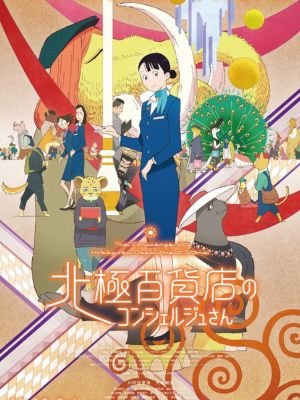
In Tsuchika Nishimura’s manga The Concierge at Hokkyoku Department Store, anthropomorphic animals are served by the titular shopping center and its staff. Production I.G.’s anime adaptation, The Concierge, may have been only a fraction as long as the comic which ran for almost two years, but it turned out to be a hilariously well-made rendition of Nishimura’s whimsical concept. It is also a touching exploration of what places like Hokkyoku stand for: shrines to trade’s beauty, happiness and destruction.
Like in the manga, the movie revolves around Akino who works at the Hokkyoku Department Store and found the place when she was young through its doorman. She has not changed her role or employer since then – now an adult, she still works at Hokkyoku department store as a “concierge” for Very Important Animals (VIAs). (Within this context her job as concierge effectively being that of a personal shopper too.) While in reality, the set consists of just one place – where The Concierge takes place – on the screen it looks surprisingly far-reaching as if it were part of some hidden kingdom revealed in stages with each lovely vignette.
The story arc of The Concierge is founded on Akino’s training. Assuredly Akino wants to save customers flocking into high-end goods shop while foolishly trying to extinguish fires spread by some critters (figures) under the watchful eyes of floor manager (another human), boss (a penguin), and an efficiency consultant. Her more tentative nature means though that she walks into customers and even steps onto one smaller customer called great auk by mistake. This becomes obvious from this point: The bird politely asks Akino-her rehearsed yet panicky reaction caught on animation-to give him a push so he can roll along the store aisles.
This gives The Concierge a kind of modernist feel when viewed in the wonderfully expressionistic pictures by director Yoshimi Itazu and his team. The weird shapes of human figures, combined with the flat coloring and ridiculous humor resemble Masaaki Yuasa’s The Tatami Galaxy and Night is Short, Walk on Girl. A mix of cartoony styles, some simplifications (Akino’s shoes appear as triangles most of the time), and shading give this movie a beautiful, subtly stylized look. It is a mishmash of various influences; one chef looks like he came straight out of a Tintin comic book. This contributes to the cuteness overload regarding Chie Morita’s character designs: one sea mink in movie-star mode wears large-brim hat while another dons traditional dresses from all around the world.
There are also useful ways that her customers move – who have some great idiosyncratic traits – through departments’ halls where she works as a concierge at Hokkyoku.
Itazu goes even further into the territory of absurd comedy via Mr. Todo, an overbearing man overseeing work in the store within its confinements. This is differentiated by his jagged appearance and lightning bolt shaped mustache from Akino’s soft swooping lines; it makes him look like a devil that appears in comic sight gags as he comes out of pictures, coat stands and even soup tubs to offer some strict advice for novice concierge.
The store itself is also meticulously illustrated: there are crumpled textures in the various backdrops formed with white lines, warm pastel shades drenching buildings. Its façade recalls The Grand Budapest Hotel; this affected the imitation of Wes Anderson’s ornate comedy showing his own signature symmetrical compositions and staff portrayal at The Concierge who possess passionate and poetic ideas about their work.
Their idea is great fun for Itazu and Satomi Ooshima, but slowly Akino finds that her idealism crashes against problems which cannot be solved by just being kind or sincere enough. Aseal takes advantage of her generosity, while speaking an obnoxious entitled gibberish that will sound familiar to any service worker from our real world. Many conflicts in The Concierge are not far from human nature – however, they reveal a dark truth which Hokkyoku’s beautiful looking corridors try to hide behind them when mixed with dilemmas inherent in the animal kingdom.
In pieces it happens. “There are no other Japanese wolves around” says one solitary customer – basically a true story of extinction artfully tucked into one of the plotlines constituting Akino’s training days as a concierge-in-training. In fact it grows up into main theme of The Concierge – bonds that unite not only clients’ Hokkyoku but also personal qualities shown by Akino in dealing with them. For instance, discussions between Akino and these talking creatures help to bring environmental concerns home. Her pride in service becomes a reflection on human excess; the department store a reflection on our destructive appetites.
In this way, the combination of enchanting myth and stark reality makes The Concierge less of a whimsical, funny fantasy and more of a poignant, tragic commentary. It’s didactic yet powerful about how capitalism leads to extinction – one way to think about serving humanity better by looking after its other members who share the same planet as us. (I hope someone shows David Attenborough this film.) It is to Itazu’s credit that this turn feels so organic, never undermining the light tone nor being too preachy. Hokkyoku has contradictions at its heart which make it somewhat bittersweet whereas The Concierge however is sheer pleasure all through.
Verdict
The Concierge’s little vignettes and low-stakes affairs accompanied by lively expressive art style and wonderfully absurd characters create an intriguing portrait of the Hokkyokku Department Store’s fantastical ecosystem – it also provides a broader picture of what humanity does or should know regarding ecosystems around them in real life. Its premise seems light-hearted and cute but underneath there is also some sad environmentalism for those few who can see it clearly, although not without remarkable jokes.
Also, Read On Fmovies
